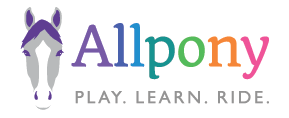Rudy the Horse & Equine Chiropractors

Hi Kids, My Name is Rudy!
I'm the star of a children's book series where I tell kids about my life while educating them on all things horse!
My owner and I have partnered with Allpony (Free Horse Learning Games & Horsemanship Quizzes for Kids (allpony.com) to bring a series of blog posts to the Allpony website that discusses equine practitioners.
Equine Chiropractors
I’m going to tell you about equine chiropractors in this edition. Mine is named Franco, and I like him a lot. Oops, I’m getting ahead of myself! Let me back up.
I am a lucky horse because my owner uses various equine practitioners to help me feel my best.
It’s easy for people to misinterpret certain horse behaviors such as biting, bucking, or bolting as being naughty when in reality, the horse is letting the person know they are in pain. One of the specialists that can help identify areas of discomfort in the horse is an equine chiropractor.

As I mentioned, my chiropractor is Franco, and he works on my spine to ensure it’s properly aligned and pain-free. He always starts by running his fingers down my back, noticing where I flinch or shrink away from his touch. If I react, I am sore and need the area adjusted.

Before Franco performs the adjustments, he injects vitamin B12 in the areas of my body that are particularly painful or problematic. Not all equine chiropractors use these injections. Vitamin B12 causes an inflammatory response sending blood to the injected areas, which helps the adjustment last longer.
Sacroiliac (SI) Joint In Horses

He usually injects me in my rump or my sacroiliac (SI) joint because this is an area that is frequently “out.” He also often injects my lower neck. The last cervical vertebra, or C7, is another area that is often out of alignment, causing me pain and a diminished range of motion in my neck.
Needles make me nervous. I anticipate the pinch and find myself high-headed and tense each time I get these injections. Sometimes, I buck before Franco can put the needles into my rump when I am particularly sore in my SI joint. He is skilled at these injections and usually succeeds despite my best attempts at preventing him from putting them into me.

Next comes the adjustments. Some equine chiropractors manually manipulate the horse’s skeletal structure with their hands, while others use hand-held instruments such as mallets to deliver an effective, fast adjustment. Franco uses mallets.
He starts where my neck connects to my head and works his way down my back to my tail, making adjustments where needed. He feels for the vertebra and then gives it a firm, fast, whack. The mallet can startle me, but it doesn’t hurt.
He uses his fist to adjust the lower cervical vertebrae, especially C6 and C7. He pushes hard against my neck while pulling my nose toward my shoulder and then releases my head to pop them back into proper alignment. Afterward, he checks my range of motion by asking me to touch my nose to my shoulder. When the vertebrae are in alignment, I have no problem touching either of my shoulders. Franco also palpates specific places on the side and top of my head to determine if my poll or TMJ is out of alignment. These two joints often need adjusting on horses.
The TMJ is the joint that enables the jaw to open and close. To adjust it, Franco delivers to quick blow underneath my jaw. He wraps his arm around my head for the poll, pulls down forcefully, and releases.
He also checks to make sure that my legs are moving freely. He picks each one up, stretches it, and circles it. When he adjusts my elbows, they make a loud “POP”!


As the chiropractor adjusts me, he periodically stops. He waits to see if I “release.” Horses release tension in their bodies in many ways, including yawning, licking and chewing, stretching the jaw, blinking, shaking their head or neck, and passing gas. For certain adjustments, he wants to see me release. If I don’t, he will adjust me again and wait until I release.
If a horse’s body is out of alignment, its body will compensate for the misalignment, and this creates stress, tension, and even injuries. This is why some people think it’s essential to give their horse ongoing chiropractic care.
After my adjustments, my body feels better, and I usually lay down and roll from side to side. When I get up, I vigorously shake and let out a big sigh. I’m a happy horse!
Written by Diane R. Jones December 30, 2021


Learn More About the Rudy Book Series
To learn more about my books, check out the Rudy website.
Follow me on Instagram @rudy.therudster or on Facebook @rudytherudster.
Learn More
Learn More About the Parts of Horses, Horse Anatomy, & Conformation

Learn More About the Parts of the Horse

Learn More About Horse Conformation

